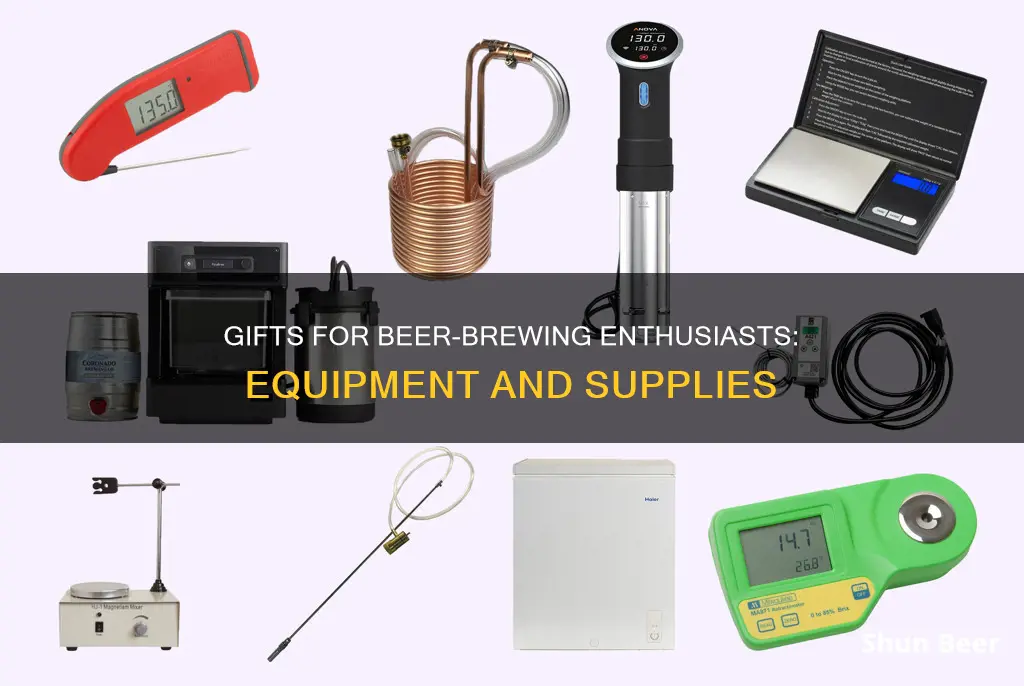
Brewing your own beer is a rewarding hobby that allows you to experiment and create something unique. If you're looking to gift something to a home brewer, there are several options to consider. For beginners, a starter kit is a great option as it includes all the essential tools and ingredients needed to get started. For those who are more experienced, you might want to consider upgrading some of their equipment, such as investing in a larger, heavy-duty stainless steel kettle, or a copper immersion chiller. In addition, books on brewing techniques and beer history can also be a good gift, as well as items like growlers, beer glasses, and bottle openers.
| Characteristics | Values |
|---|---|
| Brewing equipment | Brewing kettle, funnel, bottles, caps, siphon, airlock, stopper, racking cane, grain steeping bag, thermometer, hydrometer, bottle filler, bottle brush, bottle capper, etc. |
| Ingredients | Grains, malt, hops, yeast, DME, priming sugar, spices, etc. |
| Cleaning and sanitizing supplies | Powdered cleanser (e.g. PBW), bleach or iodine solution, electric dishwasher, cleanser, sanitizer (e.g. Star San), etc. |
| Books and learning resources | The New Complete Joy of Homebrewing, The Oxford Companion to Beer, The Brewmaster's Table, Tasting Beer, The Complete Beer Course, etc. |
| Starter kits | Northern Brewer Brew Share Enjoy Homebrew Starter Kit, MoreBeer Premium Home Brewing Kit, Northern Brewer Craft Beer Making Kit With Siphonless Fermenter, True Brew kit, Mr. Beer kit, etc. |
What You'll Learn

Brewing equipment
Brewing Kettle
A brewing kettle, or stock pot, is used to boil the wort, which is the industry term for malty sugar water. It is one of the most important pieces of equipment as it is needed to boil the wort and add hops at specified intervals to impart the desired bitterness, flavour and aroma to the beer. A good-quality brewing kettle should be made of stainless steel and have a capacity of around 5 gallons (19 litres). It should also have comfortable and sturdy handles for easy handling, especially when the kettle is full of hot liquid.
Fermenter
The fermenter is used to ferment the wort into beer. It can be made of food-safe plastic or glass, but plastic is generally preferred as it is easier to sanitise and less fragile than glass. A wide-mouth fermenter with a ball valve is ideal as it makes it easier to pour the beer and allows for siphonless transfers. A fermenter with a capacity of around 5 gallons (19 litres) is standard for most home brewers.
Airlock
An airlock is a crucial piece of equipment that allows carbon dioxide produced during fermentation to escape while preventing unwanted wild yeast and bacteria from contaminating the beer. There are two common types of airlocks: an S-shaped single-piece type and a three-piece "floater" design. Either one will work effectively.
Hydrometer
A hydrometer is used to measure the sugar content of the wort and determine the alcohol content (ABV) of the beer. It is an essential tool to ensure that the fermentation process is complete before bottling the beer. A triple-scale hydrometer is a good option as it can measure a wide range of sugar concentrations. Polycarbonate plastic hydrometers are more durable than glass ones and less likely to shatter if dropped.
Fermentation Thermometer
Temperature control is vital during the brewing process, especially during fermentation. A fermentation thermometer helps monitor the temperature to ensure it stays within the ideal range for the chosen yeast strain. A stick-on aquarium-type thermometer is a good option as it can be easily attached to the fermenter.
Bottling Equipment
Bottling equipment includes a bottling bucket, transfer tubing, a bottle capper, bottle caps and a bottling wand. The bottling bucket is used to mix the finished beer with priming sugar before bottling. Clear vinyl tubing is used to transfer the beer from the fermenter to the bottling bucket and then into the bottles. A bottling wand is a rigid piece of plastic tubing with a spring-tip valve that makes it easier to fill the bottles without aerating the beer. A bottle capper is used to seal the bottles with caps, and most kits include enough caps for the first batch.
Sanitiser
Sanitiser is crucial to prevent infections and off-flavours in the beer. A no-rinse sanitiser, such as Star San, is recommended as it is more effective against wild yeast and bacteria. Oxygen-based cleansers are also commonly included in brewing kits, but they are not as effective as no-rinse sanitisers.
Helium Beer: Can You Buy This Gaseous Brew?
You may want to see also

Sanitising products
Sanitisation is a crucial step in the brewing process. It involves treating equipment with a chemical solution to eliminate spoilage organisms such as moulds, wild yeasts, and bacteria. It is important to note that sanitisation is different from sterilisation, which is the complete elimination of spoilage organisms and is not realistic in a home-brewing environment.
- Cleaners vs Sanitisers: It is important to understand the difference between cleaners and sanitisers. Cleaners are used to remove visible dirt, stains, and residue, but they do not kill spoilage organisms. On the other hand, sanitisers are used to reduce bacteria and contamination to insignificant levels. Sanitisers should only be used on clean surfaces, as their ability to kill microorganisms is reduced by the presence of dirt and grime. Therefore, equipment must be thoroughly cleaned before sanitising.
- Sodium Percarbonate: This is a very effective sanitiser for all types of brewing equipment, including stainless steel kegs and pots. It is a combination of sodium carbonate and hydrogen peroxide, which effectively removes dirt and provides some degree of sanitisation. It is environmentally friendly and requires little to no rinsing.
- Phosphoric Acid and Sulphonic Acid Mixes: These are no-rinse sanitisers that are highly effective in killing organisms. They have a low contact time and can break down into yeast nutrients if small amounts are left behind. They may cause foaming when agitated, but this residue will be broken down by yeast.
- Star-San: Star-San is a flavourless, odourless, and no-rinse food-grade sanitiser. It acts quickly, usually within 5 minutes, and can sanitise hard-to-reach places like cracks and crevices. It leaves a microscopic protective film on sanitised items, ensuring continued protection even after drying. It is environmentally friendly and will not harm helpful bacteria in septic systems.
- Iodophor: Iodophor is an iodine-based detergent, germicide, and sanitiser commonly used by homebrewers. It is a no-rinse sanitiser and is easy to use. It takes about 10 minutes to sanitise equipment with a 12.5 PPM solution. The solution can be reused as long as it retains its original orange-amber colour.
- Heat: Boiling the wort is an effective sanitisation method. Immersion wort chillers can be sanitised by immersing them in the boiling wort for the last 15 minutes of the boil. Heat can also be used to sanitise bottles and heat-resistant equipment in an oven, but this requires extra time and can weaken the bottles.
- Chlorine Bleach: Chlorine bleach is effective for sanitising glass equipment. However, it should be avoided for plastic as it can be absorbed, leading to off-flavours in the beer. It is also not suitable for stainless steel as prolonged contact can eat through the material. Additionally, chlorine can kill yeast cells, so proper rinsing is crucial to avoid fermentation problems.
- Dishwashing Detergents: Mild, unscented dishwashing detergents like Ivory brand can be used for light-duty cleaning of boiling pots, spoons, funnels, and strainers. However, they are not suitable for fermenters, airlocks, beer bottles, and caps.
Best Places to Buy 512 Beer in Austin
You may want to see also

Ingredients
Brewing beer is simple and only requires four ingredients: malt, hops, yeast, and water. However, many popular styles also use other ingredients, including lactose, spices, and other flavourings.
Grains
The first step in brewing beer is to make wort, which is the industry term for malty sugar water. There are two ways to make wort: extract brewing and all-grain brewing. The former is the easier method and simply involves dissolving liquid or powdered malt extract in hot water. All-grain brewing, on the other hand, involves steeping a large quantity of crushed malted grain in hot water. The type of grain used will depend on the kind of beer being made.
Malt
Malt can be bought in dry or liquid form. The liquid variety is easier to measure and work with, so it is recommended for beginners.
Hops
Hops are optional and depend on the recipe being followed. They are added at specified intervals to impart bitterness, flavour, and aroma to the beer. The amount of hops used depends on the style of beer being brewed. For example, IPAs use a lot of hops, whereas American lagers use very little.
Yeast
Yeast is added to the wort to consume the sugar and produce alcohol and carbon dioxide. It comes in both dry and liquid forms, but most recipe kits use dry yeast for its longevity and reliability.
DME or Priming Sugar
DME (dried malt extract) or priming sugar is used to preserve the beer after bottling.
St. Patrick's Day: Where to Find Green Beer
You may want to see also

Bottling equipment
Bottles: Collecting and sanitising bottles is an important step in the bottling process. It is recommended to start collecting non-screw top bottles in advance, as they will need about 50 bottles to bottle a standard batch of beer. Glass bottles are preferred, and old recyclable glass soft drink bottles or champagne bottles can also be used.
Bottle Brush: A bottle brush is handy for thoroughly cleaning and sanitising the bottles before filling them with beer. It ensures that no residue or contaminants are left in the bottles, which could affect the taste or quality of the beer.
Bottle Filler: A bottle filler, also known as a bottling wand, is attached to the tubing and helps to fill the bottles with beer. It has a spring-tip valve that allows for controlled filling and reduces the risk of overflow or spillage.
Bottle Capper: A bottle capper is used to seal the bottles with caps after filling. The most common type is the wing-type bottle capper, which is easy to use and comes with most home brewing kits.
Bottle Caps: Buying bottle caps in bulk ensures that the brewer always has enough caps to seal their bottles. They come in various materials and colours, allowing for customisation and a professional look.
Bottling Bucket: A bottling bucket is a second bucket used to mix the beer with priming sugar before bottling. It has a plastic ball valve and clear vinyl tubing attached to it for easy transfer of the beer into the bottles.
Transfer Tubing: Clear vinyl tubing is used to transfer the beer from the primary fermenter to the bottling bucket and then into the bottles. It is important to sanitise the tubing before each use to prevent contamination.
Hydrometer: A hydrometer is a crucial tool for determining the sugar content of the wort and ensuring that fermentation is complete before bottling. It also helps home brewers calculate the alcohol by volume (ABV) of their beer.
Sanitiser: Sanitiser is essential for cleaning and sanitising all equipment that comes into contact with the beer after boiling. It helps prevent infection and the growth of unwanted organisms that can cause off-flavours in the beer. Common sanitisers include Star San, iodine-based sanitisers, and powdered cleansers like Powdered Brewery Wash (PBW).
German Wheat Beer: Where to Buy and What to Know
You may want to see also

Books and resources
- The Oxford Companion to Beer by Garrett Oliver: This book covers everything from the technical aspects of brewing to the culture and can be a great resource for someone who wants to learn more about beer.
- The Brewmaster’s Table: Discovering the Pleasures of Real Beer With Real Food by Garrett Oliver: This book can be a good read for someone who knows they like drinking beer but doesn’t know much about the history or different styles of brewing.
- Tasting Beer: An Insider’s Guide to the World’s Greatest Drink, Second Edition by Randy Mosher: This book can be a great guide for those who want to learn how to taste beer and better develop their palate.
- The Complete Beer Course: Boot Camp for Beer Geeks: From Novice to Expert in Twelve Tasting Classes by Josh Bernstein: This book can be a crash course for someone who wants to learn about beer.
- The New World Guide to Beer and Michael Jackson’s Beer Companion: The World’s Great Beer Styles, Gastronomy, and Traditions by Michael Jackson: These books by the late English beer critic and author Michael Jackson are deep cuts for those who know about beer.
- Brewing Up a Business by Sam Calagione: This book combines expertise from the author's years in the beer world with practical entrepreneurship tips and strategies and can be a great choice if the person you’re gifting has ever thought about going into the business or is interested in knowing how it works.
- Beer & Brewing Magazine Subscription: This magazine subscription can make a great gift for someone who’s a bit more advanced in their beer obsession.
- John Palmer’s How to Brew: This is a great, free introduction to brewing your own beer.
- Charlie Papazian’s The New Complete Joy of Home Brewing: This book provides an introduction to brewing your own beer.
- Homebrewing 101 course by Northern Brewer: This is a five-chapter seminar that offers a great overview of the basics of the brewing process, from equipment and sanitizing to brewing and fermenting.
Phins and Feathers Beer: Where to Buy?
You may want to see also
Frequently asked questions
A basic home-brewing kit is a great place to start. It includes all the equipment and step-by-step instructions needed to brew a gallon-sized batch.
For more advanced brewers, you could upgrade one piece of their setup, like a glass carboy for fermenting.
Beer-themed gifts like glassware, openers, books, or a subscription to a beer magazine are all great options.







